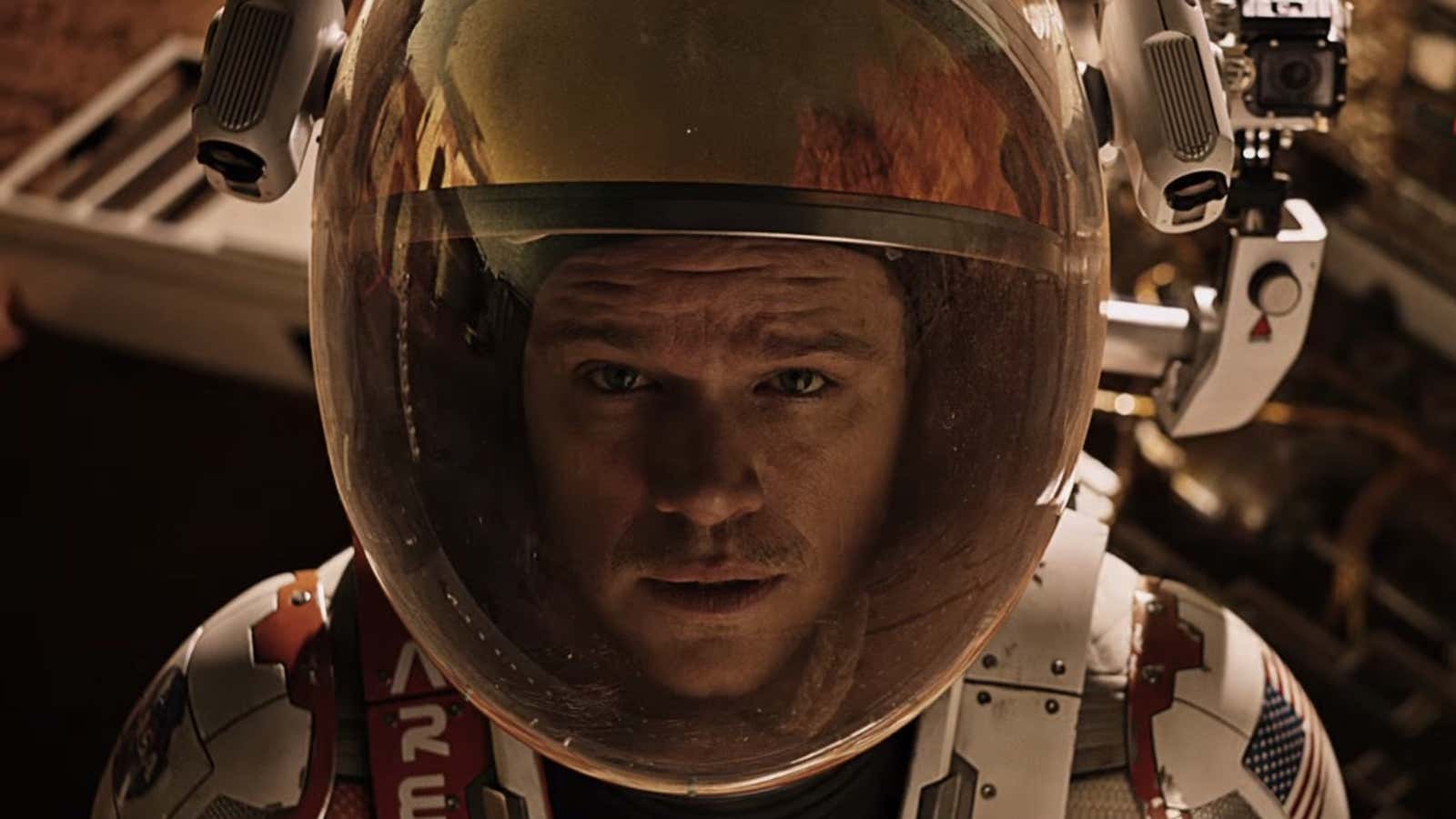There’s a moment relatively early on in Ridley Scott’s “The Martian” when it becomes clear just how alone Matt Damon is.
After being left for dead by his crew, waking up in a pile of dust with a metal spike sticking out of him, Mark Watney (played by Damon) clamors back to the habitat and performs emergency surgery on himself. After he staples himself together, sitting in a chair, he ponders the fact that home is 50 million miles away, and no other human will be coming back to Mars for four years. Watney decides he doesn’t want to die on the Red Planet, and sets about figuring out how to survive there, documenting his every action on his trusty GoPro.
GoPros, of all things, manage to pervade “The Martian.” What starts out as a narrative device—the film is mainly about someone alone on Mars who needs some way to tell the audience what he’s doing even though there’s no one to talk to—the GoPro ends up seeming like a confidant for Watney. Perhaps he recorded and narrated everything he was doing out of posterity, to show future explorers where he went wrong—or because talking to something helps keep Watney sane as the months alone dragged on.
Unlike most summer blockbusters, there was not a ton of product placement in the film (although Cisco still manages to be the telepresence solution of choice for NASA in the 2030s). There were Panasonic Toughbook laptops with the branding duct-taped over, and yet, every camera that Watney had was a GoPro—there were even GoPros strapped on as body cameras on the astronauts (before they left Mars), and GoPros seemingly acting as webcams for the astronauts to record messages to send home. GoPros had more screen time than Kristen Wiig or Donald Glover.
I asked GoPro if this had been product placement, and the company suggested it had been the doing of director Ridley Scott, but had worked in collaboration with him. And the company definitely trumpeted the inclusion: GoPro published a blog post Oct. 1 celebrating Scott’s use of its tiny cameras, calling it “the biggest cinematic integration of GoPro in a Hollywood release.”
In a recent interview with Entertainment Weekly, Scott said the GoPro proved an elegant solution for adapting a source novel that was written in the first person:
Can Mark Watney keep us paying attention through quite a lot? What we came up with is that you have to give him something else. Our solution was the GoPro that is everywhere where he is. They record everything—they’re like the black box on an aircraft. So if you have a GoPro present and no one else to talk to, it suddenly becomes a buddy. Matt was able to talk to it that way. So it was tricky but it never became a problem because Matt Damon is such a great humorist.
In its blog post, GoPro compared its camera to the volleyball (“Wilson“) that Tom Hanks’ character befriends in the 2000 film “Castaway.” Scott told GoPro that the cameras were originally intended to be that sort of crutch for Watney. “They became a character in the movie,” Scott said, adding that they “helped drive aspects of the story forward and gave the world an extra layer of authenticity and familiarity.” And the comparison to Wilson seems apt: If the average person is stranded alone with a camera—be it on a desert island or desert planet—they’re probably going to talk to it, because what else are they going to do?
Scott ended up using footage from the GoPros—they were all actually recording when Damon was speaking into them—in the final cut of the film. The GoPros, which us Earthlings tend to use to record extreme sports, or other exciting life events, become like security cameras—capturing the monotony of Watney’s Martian life from fly-0n-the-wall angles, as well as confidants.
Like much of the technology found in ”The Martian,” NASA actually does use GoPros on many of its missions, NASA spokesperson Stephanie Schierholz told Quartz. “Imagery is an incredibly important part not only of sharing NASA’s mission but also for our teams to see and evaluate various aspects of missions from an engineering perspective,” Schierholz added. Much of the footage shot on GoPros from the International Space Station and other space missions, including some dramatic spacewalks, is available online.
“The Martian” is a beautiful, dusty, lonely space epic that actually seems quite scientifically accurate—at least as much as a film about something we aren’t able to do yet can be. And somehow, in a movie that explores the need for space exploration in the face of disaster, a lowly, anachronistic extreme sport camera from 2015 takes center stage next to an all-star cast. Perhaps this will be welcome news for GoPro CEO Nick Woodman, as the company’s stock is down over 53% on the year, slashing his personal net worth by $1.4 billion. Perhaps instead of drones, the company should start thinking about a deal for cameras with space agencies, or Matt Damon. He seems quite taken with them.
